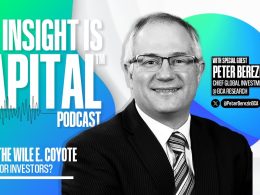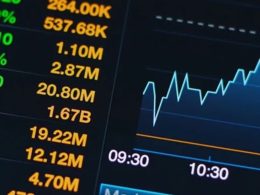by CFA, Director, Fixed Income, Schwab Center for Financial Research
LIBOR is a term investors and consumers alike have probably heard before, although you may not know exactly what it is. But now the scandal-marred rate is set to be phased out in a few years. Below, we’ll discuss the basics of LIBOR, why it’s going away, and what that may mean for investors and consumers.
What is LIBOR?
LIBOR stands for London Interbank Offered Rate. These rates—there are 35 of them across various maturities and currencies—are administered by the Intercontinental Exchange, or ICE, and are sometimes referred to as ICE LIBOR rates. LIBOR rates are rates that banks charge each other for short-term loans. More specifically, LIBOR “provides an indication of the average rate at which a LIBOR contributor bank can obtain unsecured funding in the London interbank lending market for a given period, in a given currency,” according to the ICE.1
LIBOR rates are set every business day. Rates can be as short as an overnight rate and as long as a 12-month rate. LIBOR rates are set in five currencies: U.S. dollar, Japanese yen, Swiss franc, euro and British pound sterling. In the U.S., three-month LIBOR is one of the most frequently used rates for pegging borrowing costs.
Why does LIBOR matter?
LIBOR rates affect us both as consumers and as investors. LIBOR is often the reference rate for many different types of loans, including:
- Adjustable-rate mortgages
- Home equity loans and lines of credit
- Auto loans
- Student loans
- Credit cards
LIBOR also plays a key role in many types of investments, usually those with floating coupon rates. Rather than having fixed coupon payments, the coupon rates on these investments tend to equal a short-term reference rate, usually three-month LIBOR, plus a spread. The spread is compensation for the additional risks of holding these types of investments relative to more conservative investments like U.S. Treasury securities. According to Bloomberg, LIBOR rates represent benchmarks for more than $350 trillion in securities across the globe.2 Some common investments with floating coupon rates include:
- Investment-grade floating-rate notes
- Floating-rate or variable-rate preferred securities
- Bank loans
These investments tend to benefit when short-term rates are rising, as in today’s environment. The opposite is also true—when short-term rates fall, their coupons rates tend to fall as well.
LIBOR rates usually track other short-term interest rates, like the U.S. federal funds rate, but they can also be an indication of risk. If there are concerns about the financial system, or broad risks in the economy, LIBOR rates may rise as the banks’ cost of borrowing rises. As the chart below illustrates, three-month LIBOR tends to track the federal funds rate, but during periods of market stress—for instance, during the 2008-09 financial crisis, and, to a lesser extent, during the European debt crisis of 2011-12—the two rates have diverged.
Three-month LIBOR usually tracks the federal funds rate, but has diverged at times
Source: Bloomberg. Monthly data as of 7/31/17. ICE LIBOR USD 3 Month (US0003 Index) and U.S. Federal Funds Target Rate Mid Point of Range (FDTRMID).
The LIBOR scandal
If you’ve heard of LIBOR recently, it’s most likely not for good reasons. The rate has been marred by scandal. Because LIBOR rates are set by banks submitting their own estimates of their borrowing costs, the rates can be manipulated by those member banks—and they have been.
For instance, during the financial crisis, some banks submitted low numbers to make it appear they were in better shape than they actually were. Borrowing costs can be an indication of risk—riskier borrowers tend to be charged higher rates—so the lower rates helped masked the liquidity problems that many banks were experiencing at the time.
Some banks also tried to manipulate LIBOR rates to make profits. According to the Council on Foreign Relations, banks submitted “rates to provide figures that would benefit the traders, instead of submitting the rates the bank would actually pay to borrow money.3 In other words, banks manipulated LIBOR rates to benefit their own LIBOR-linked investments.
Since investigations began in 2012, regulators in the United States, the United Kingdom and the European Union have fined banks more than $9 billion for their participation in LIBOR-rigging schemes.4
Why is LIBOR going away?
One reason could be that it has lost creditability from the scandal. But according to the United Kingdom’s Financial Conduct Authority (FCA), the regulatory agency that oversees LIBOR, it’s because LIBOR rates don’t reflect costs from actual transactions. In a recent speech, Andrew Bailey, CEO of the FCA, said the rate will be phased out because “the underlying market that LIBOR seeks to measure—the market for wholesale term lending to banks—is no longer sufficiently active.”5 In that speech, Bailey cited an extreme example in which one of the LIBOR rates (remember, there are multiple currencies and tenors) reflected just 15 transactions of a qualifying size for all of 2016. Regulators would prefer to see reference rates that are based more on actual transactions than subjective judgments. According to the FCA, LIBOR is set to be phased out by the end of 2021.
What does this mean for investors?
There are currently working groups trying to come up with alternative rates that can be used as benchmarks. The Alternative Reference Rate Committee is studying potential replacements, and the leading proposal is the Broad Treasury Financing Rate, which would be based on a broad set of U.S. Treasury financing transactions.6 According to the Federal Reserve, these rates should be published sometime in the first half of 2018.
How this translates to investors and consumers is a little less straightforward. Each investment, security, or loan that cites LIBOR as its reference rate has its own contract with its own set of terms. Unless a back-up rate is listed in a prospectus or contract, the new rate and terms will need to be agreed upon between the borrowers and the lenders.
For investors, many investments that track LIBOR rates tend to be short-term in nature. For example, average maturity of the issues in the Bloomberg Barclays U.S. Floating-Rate Note Index is just 2.6 years, and only 8.3% of the issues in the index have maturities beyond five years.7 Bank loans, a riskier type of corporate debt that tracks LIBOR, tend to have short maturities as well. Many of these investments may simply mature before the phase-out occurs.
Investments with longer maturities, like preferred securities, likely will need to be addressed on a case-by-case basis. Most preferred securities have call features, meaning the issuer can “call,” or redeem, them at their par price after a certain date has passed. Given that many floating-rate preferred or variable-rate preferred securities use three-month LIBOR as their benchmark, issuers may choose to call in the securities at the next available call date close to the LIBOR phase-out date. According to CreditSights, an independent research firm, the LIBOR phase-out likely would not allow the issuers to redeem their preferreds at their par value prior to the first call date, however.8
Any change to an underlying reference rate likely would require consent from holders of such investments. In most situations, consent is required by some sort of majority of the investors. This could be a long and drawn-out process.
While there are still plenty of unknowns, investors will want to see how the alternative reference rates stack up to the original LIBOR rates their investments tracked, to make sure the new yield compensation is adequate. In other words, if a new reference rate is lower than what a given LIBOR rate would have been, investors’ income may be lower than initially hoped for.
Another risk is the implementation of alternative reference rates. For example, if in a few years corporations begin to issue floating-rate notes with a new reference rate, seasoned floaters that are still tied to LIBOR may be less desirable and could potentially experience a loss of liquidity. In the bond market, lower liquidity usually leads to a large gap between what a bond can be bought or sold for, and usually leads to more price volatility. This could negatively affect holders of these types of investments.
What to do now
Unfortunately there are still many unknowns when it comes to LIBOR-linked investments. Considering that the projected phase-out is still four years away, the transition to new benchmarks is likely to be orderly. But we do see some risks as we get closer to the phase-out date. For investors who own LIBOR-linked investments, higher-than-normal price volatility may arise if the transition doesn’t go as smoothly as planned. We think it’s important to pay attention to how this unfolds so you won’t be surprised if and when these changes impact your investments.
1 Source: Intercontinental Exchange website.
2 “LIBOR Funeral Set for 2021 as FCA Abandons Scandal-Tarred Rate,” Bloomberg, July 27, 2017.
3 “Understanding the LIBOR Scandal,” Council on Foreign Relations, October 12, 2016.
4 Ibid.
5 “The Future of LIBOR,” Financial Conduct Authority, July 27, 2017.
6 “Introducing the Revised Broad Treasuries Financing Rate,” Federal Reserve Bank of New York, June 19, 2017.
7 As of August 16, 2017.
8 “Goldman 1H17 Review: Callables, Replacing LIBOR,” CreditSights, August 1, 2017.
*****
Important Disclosures
The information provided here is for general informational purposes only and should not be considered an individualized recommendation or personalized investment advice. The investment strategies mentioned here may not be suitable for everyone. Each investor needs to review an investment strategy for his or her own particular situation before making any investment decision.
All expressions of opinion are subject to change without notice in reaction to shifting market or economic conditions. Data contained herein from third party providers is obtained from what are considered reliable sources. However, its accuracy, completeness or reliability cannot be guaranteed.
Past performance is no guarantee of future results and the opinions presented cannot be viewed as an indicator of future performance.
Fixed income securities are subject to increased loss of principal during periods of rising interest rates. Fixed-income investments are subject to various other risks including changes in credit quality, market valuations, liquidity, prepayments, early redemption, corporate events, tax ramifications and other factors. Lower-rated securities are subject to greater credit risk, default risk, and liquidity risk.
Copyright © Schwab Center for Financial Research















